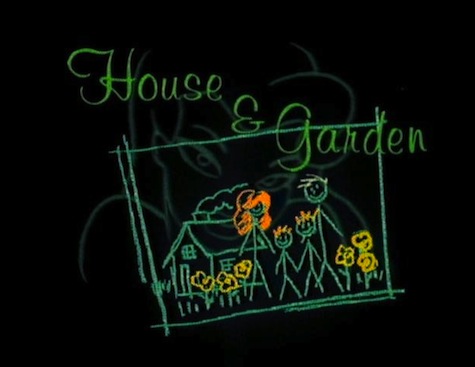“House and Garden”
Written by Paul Dini
Directed by Boyd Kirkland
Episode #070
Music Composed by Shirley Walker
Animation by Dong Yang Animation, Inc.
Original Airdate—May 2nd, 1994
Plot: Poison Ivy gives up her criminal ways, gets married, and raises two kids in the suburbs. But if Ivy’s reformed, then who is using giant plant monsters to rob wealthy young men in Gotham, including Dick Grayson?
Recidivism episodes humanize the Batman villains by showing what they are like when they are not threatening to destroy Gotham. But the increased sympathy makes their inevitable, pathological reversion to their criminal selves all the darker. They stop being cardboard cut out “bad guys” and start becoming complicated, likable people who nevertheless do horrible, unforgivable things.
Such is the case with “House and Garden” and Poison Ivy. So far, Ivy has been a parodic extreme of environmentalism/feminism, using sympathetic causes to justify her selfish crimes, giving her just enough sympathy without ever threatening her status as the villain of the story. Here, Ivy’s need for family seems much more sincere and human, and therefore her extreme method of acquiring a family becomes that much more horrifying.
For the first two acts, “House and Garden” plays on the severe contrast between the gothic horror of Gotham and the placid normalcy of its suburbs. As in “Sideshow,” there’s the suggestion that the weirdness of Gotham really is restricted to its city limits, and once you get outside your chances of being mauled by a walking cactus is radically reduced. Gotham is all darkness, Art Deco skyscrapers, and hulking monsters coming out of the fog. Meanwhile, Ivy’s neighborhood is filled with Norman Rockwell parks, farmers markets, and station wagons for dropping the kids at school. Batman seems both out of place and faintly ridiculous sitting in a tree against a clear blue sky.
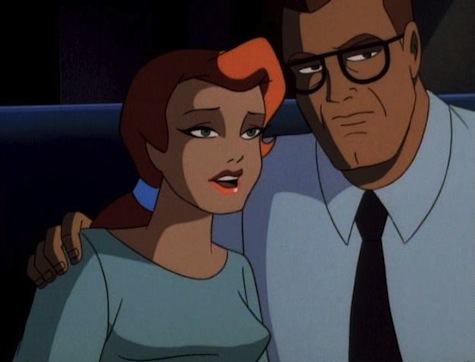
Paul Dini and Boyd Kirkland play with the difficulty in writing a real mystery in the Batman universe. As Ivy herself says, if a vegetable based crime happens, she’s the “first, and probably only suspect.” So Dini and Kirkland do what they can to show that Ivy’s reform, or at least her desire to reform, is sincere. She is happy living as a housewife. She does want to leave her past at Arkham, with “the obsessed and the insane,” behind. Maybe her experience in “Trial” got to her and she’s realized she is responsible for her own crimes. (There’s been another time jump because “Trial” was two episodes ago and yet Ivy has been out of the Asylum for six months. And how did Batman not know Ivy was a free woman for six months?) Ivy rejects her criminal past, her nom du crime, and even her weaponized overt sensuality. In “Harley and Ivy,” Ivy couldn’t even hang out in her own home without falling into pin-up poses and called housework “female domestic slavery.” Here, she wears frumpy sweaters, her hair pulled back in a conservative ponytail, and insists she be called “Mrs. Carlyle.”
But of course the suburbs hide their horrors just under the surface. Ivy’s husband and kids are actually plants turned into people (inverting her crime in “Eternal Youth” of turning people into plants), copies of an Arkham psychiatrist Ivy seduced, manipulated, and then kept locked in a tank under her greenhouse. Kirkland really delivers the creeps in the reveal of the pod-children with an arm bursting from a tank of water, the eerie echo of children calling for their mommy, and wet green plant pods paying homage to the facehuggers from Alien, the pod-people of Invasion of the Body Snatchers, and the body horror of David Cronenberg.
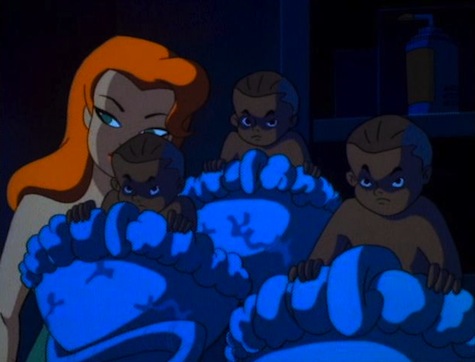
As in “Tyger Tyger,” we’re getting into some pretty sci-fi questions of what actually constitutes a human (the plant monsters are even voiced by Jim Cummings and so sound like Tygrus). When not in monster form, Ivy’s plant people display some independence. Mr. Carlyle is over-protective of his wife and “former patient.” Meanwhile, her “kids,” like all the kids on the show, love Batman. Which makes it so much worse when their innocent appearance is torn away and they Hulk-out into monsters.
But the real creeps in the episode are psychological. Poison Ivy wants an intimate, loving relationship, but can only have one with someone she completely controls, down to a cellular level. This explains why she sees marriage as a trap to use against Harvey Dent, but it also shifts our understanding of Ivy’s previous motives. She still prefers plants to people, but she doesn’t want a wild rainforest like Ra’s al Ghul (or Veronica Vreeland). Ivy wants a garden that lives and dies at her whim. The implications for her relationship with Harley Quinn are dire. Ivy can only be friends with Harley as long as Ivy can shape and control Harley. As soon as Harley shows a little independence, wishing for the Joker back, Ivy throws mud at her. At least the Joker is up-front about his abuse of poor Harley.
Ivy’s pathological need to control the people around her is all the more disturbing because the motivations for her psychosis are unknown. At least in the Animated Series, Ivy has no origin, not for her super immune system, nor for her psychic connection to plants, nor for her obsessive need for control. Ivy knows that her super powers means she cannot conceive her own children, which implies she tried to have kids at one time. All of this points to some horrible trauma in Pamela Isley’s past that has made her the monster she is, but Dini leaves it to the viewers imagination to determine exactly what that is.
And then Kirkland and Dini hit us with the capper: Ivy, having finally left Gotham, crying over her scrapbook of memories. A villain crying over everything they’ve lost recalls the end of “Heart of Ice,” and seals the sincerity of Ivy’s desire for reform. Ivy thinks as fondly of her marriage, as much of a sham as it is, as she does her time with Harley or her attempt to kill Harvey Dent (I guess that time she made old people horny before killing them is best forgotten.) Ivy is totally sincere. She was happy living as a housewife. I wonder what would have happened if Ivy didn’t need to kidnap and assault people for her plan to work. If no other human was harmed, would Batman have let Ivy play house with her plant puppets, like Karl Rossum living on a farm with just his robots?
Ivy’s desire for love and inability to trust is (say it with me) a dark reflection of Batman. Bruce desperately wants to believe that Ivy has actually reformed, that his villains are not doomed to be villains and therefore he is not doomed to fight them. The relief and respect with which he addresses Ivy as “Mrs. Carlyle” are palpable, and yet Batman can’t trust her, mostly because she’s lying. Like “Perchance to Dream,” Batman cannot accept a lie, even one he desperately wants to be true.
This is maybe Boyd Kirkland’s best direction job yet, which considering his track record is really saying something. Besides the brilliant horror reveal of Ivy’s true children, Kirkland filled “House and Garden” with great visual moments. The Bruce Timm designed cactus monsters, despite being giant, spend most of the episode in the shadows, and when the strike, like driving Bruce’s face into his steering wheel, they seem powerful and dangerous. But Bruce strikes back, with a hidden bullet-proof vest (shown, never mentioned) and the first appearance of the Bat Jet Ski. And when Robin joins in and starts fighting with hedgeclippers, the action goes insane (apparently you can dismember plant monsters as violently as a ventriloquist doll), all leading to the image of an Ivy clone melting in Batman’s arms.
This episode features a really good use of Robin. Yes, he does spend the better part of the episode a hostage, again, but as soon as he’s freed he provides the key clue Batman needs to uncover Ivy’s scheme, does unnecessarily acrobatic flips while spying on the Carlyle’s, and then manfully holds off an squad of cactus monsters while Batman delivers the coup de grace. There’s also the beginning of the idea of Dick Grayson outgrowing the Robin persona, since Bruce calling for help interrupts Dick’s “study session” with blonde co-ed Cindy (played by Megan Mullally). Dick is starting to become his own man, and that’s going to lead to problems.
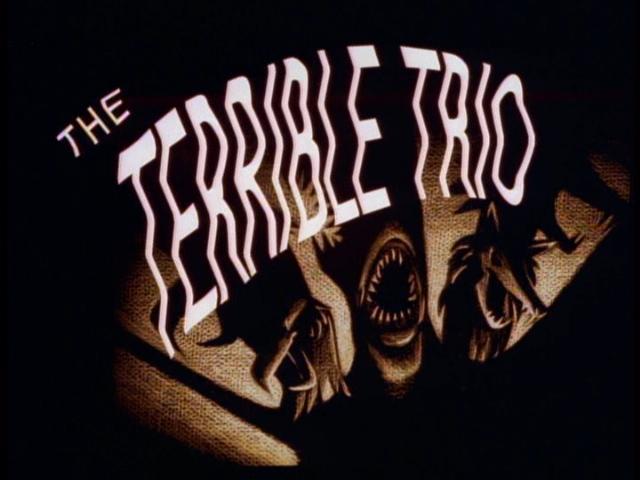
“The Terrible Trio”
Story by Alan Burnett, Michael Reaves
Teleplay by Michael Reaves
Directed by Frank Paur
Episode #071
Music by Shirley Walker
Animation by Jade Animation
Original Airdate—September 11th, 1995
Plot: Three wealthy bored young men try their hand at supervillainy.
It would be trite to say this episode is terrible, but “The Terrible Trio” certainly isn’t good. Most reviews condemn this episode on one scene of Bruce Wayne shooting skeet: the image of Batman using a gun, even for sport, being so antithetical to the character that it demonstrates a severe lack of understanding of Batman. But really, it’s just one scene, and if the rest of the episode were good, it could easily be ignored or written off.
The real problem with “The Terrible Trio” is that it’s the first episode to feature completely unsympathetic villains. The Terrible Trio are Gotham versions of Leopold and Loeb, men convinced by their wealth and privilege that they are Nietzschian ubermenches, “beyond limitations, beyond restrictions.” So the Trio escalate from theft to assault to murder simply for the thrill of it and to prove their superiority.
Even the worst of Batman’s villains have a core of understandable motivation. Poison Ivy is a monster but her need for love and family is utterly human. HARDAC and Ra’s al Ghul want to wipe out the human race, but they want to do so to save the planet. Kyodai Ken and the Clock King want revenge for (perceived) injustices. Batman says “Scoundrels like these are worse than the Joker. At least he’s got madness as an excuse.” But more than his madness, the Joker’s “excuse” is that he’s a cartoon character, more a force of chaos than a three dimensional human being. And the Joker is funny.

In comparison, Warren Lawford (Bill Mumy), the leader of the trio, is a joyless tool, and we’re never given a single reason to like him. He looks down on everybody, including Bruce Wayne, his two compatriots, and his “girlfriend,” who he pays off like a prostitute. He’s an arrogant, spiteful, callous jerk who, tellingly, only inherited the wealth that justifies his pride. I hate Warren, and not in a fun “love to hate, can’t wait to see you get yours” Walder Frey sort of way, and unfortunately he’s the protagonist of the episode. Rather than be the lead, Warren would have made a great third party in a more typical Revenge Origin plot, playing the Roland Daggett or Ferris Boyle role to some more sympathetic villain.
What’s obviously missing from this episode is the presence of any “real” supervillain. Instead of ending on a distasteful prison rape threat, with generic thug closing in on a now imprisoned Warren, what if it had been the Penguin that jumped off the bunk? What would the supervillain who wants to be an upper class snob think about an upper class snob that wants to be a supervillain? We’ve seen how the Joker reacts to plutocrats appropriating his schtick (not well), but how would Catwoman react, considering she’s also a socialite by night and burglar by later that same night? Or, going in the other direction, what if the Terrible Trio had run into Roland Daggett or (with some finagling) Lex Luthor? “Oh, you’re rich young men who think yourselves beyond the concept of good and evil? Let me show you how to really be super men.”
Also, focusing so much on Warren and his soap opera shenanigans give short shrift to Batman and Robin. Robin’s presence feels particularly superfluous to this episode, as he does nothing but show off his R-shaped shuriken, walk into a trap, and then fly the plane at the end. And Batman doesn’t accomplish much more than that. Despite the fact that Warren does nothing to hide his voice, and wears an identifying ring at all times, Batman takes way too long to identify the Terrible Trio, and once he does he immediately shuts them down. Perhaps that’s because, for all their wealth, the Terrible Trio are just men with guns, and Batman beats men with guns like paper covers rock.
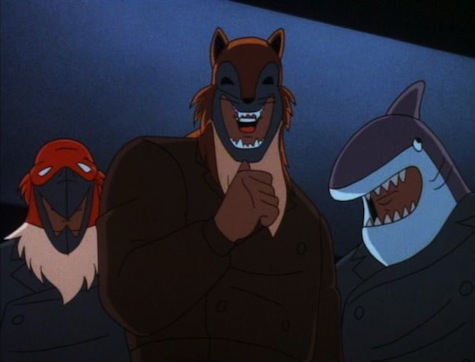
In the end, “The Terrible Trio” is more disappointing than anything else. There’s a lot of good effort here, another great score by Shirley Walker, above par animation from Jade Animation, some nice, tense directing from Frank Paur. Even the voice acting, from Bill Mumy to Hector Elizando as the (very white) patron Sheldon Fallbrook, is top notch. And the core idea, supervillains that originate in the upper class rather than merely prey upon them, has strong potential, as it’s in opposition to the rest of rogues. But Warren is just so unlikable that the whole episode fails. If “Heart of Ice” proves that the best Batman villains are the most sympathetic, “The Terrible Trio” is exhibit A that the worst Batman villains are just hateful jerks.
Steven Padnick is a freelance writer and editor. By day. You can find more of his writing and funny pictures at padnick.tumblr.com.










